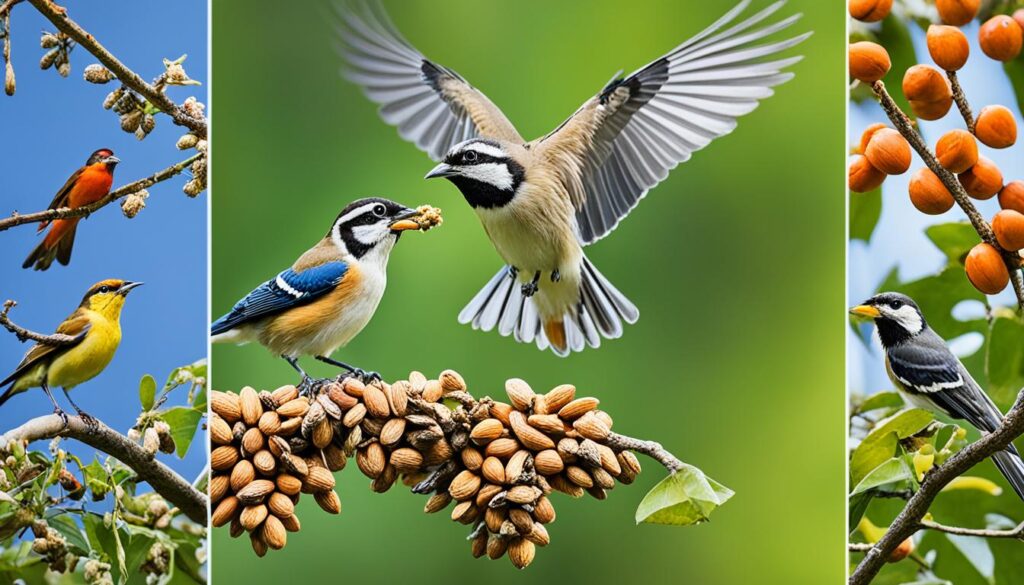Did you know that the European Bee-Eater (Merops apiaster) is known for its unique ability to remove the stingers from bees before consuming them? This remarkable avian predator is just one example of the diverse feeding habits and nutritional needs of birds. In fact, a recent study by the World Economic Forum found that Europeans who have more bird species in their day-to-day life tend to be happier, underscoring the profound impact that our feathered friends can have on our well-being.
Understanding the frequency and patterns of bird feeding is crucial for appreciating the intricate relationships between these remarkable creatures and their ecosystems. From the high-metabolism of small birds that require frequent meals to the varied diets of raptors like hawks and owls, the ways in which birds acquire and consume their sustenance reveal the remarkable adaptations that have enabled them to thrive in diverse environments around the world.
Key Takeaways
- Birds have diverse feeding habits influenced by factors like metabolism, body size, and seasonal changes.
- Small birds with high metabolisms feed frequently throughout the day, while larger raptors may only need to hunt every few days.
- The crop, a storage pouch in the esophagus, allows some birds to cache extra food for later.
- Birds exhibit various feeding behaviors, including prey sharing, loafing after meals, and adjusting patterns based on weather conditions.
- Understanding avian feeding habits is crucial for appreciating the intricate relationships between birds and their ecosystems.
Introduction to Bird Feeding Habits
Birds have a diverse range of avian feeding behaviors and bird dietary patterns that are vital to understanding their bird nutrition and overall health. Factors such as body size, metabolism, and seasonal changes all play a crucial role in determining how often birds need to eat to meet their energy demands.
Observing and comprehending these feeding habits can provide invaluable insights into the well-being of bird populations. Small birds, for instance, require frequent meals to sustain their high metabolisms, while larger birds like raptors may feed less often but consume more substantial prey.
“Proper nutrition affects bird behavior, influencing their energy levels, social interaction, and breeding success.”
Feeding station observations have shown that the abundance of garden birds increases with the levels of bird feeding, highlighting the importance of responsible and informed bird feeding practices. By understanding the unique bird dietary patterns of different species, we can ensure that our feathered friends receive the nutrients they need to thrive.
Feeding habits can also vary significantly by season, with birds adjusting their diets and feeding frequencies to adapt to changing environmental conditions. This knowledge can help us provide the appropriate food and support for birds throughout the year, contributing to their overall well-being and the health of local ecosystems.
Factors Influencing Bird Feeding Frequency
The frequency of bird feeding is influenced by several key factors, including metabolism and body size, as well as seasonal changes. Understanding these factors is crucial in comprehending the feeding habits of our feathered friends.
Metabolism and Body Size
Small birds, such as hummingbirds and warblers, possess high metabolic rates due to their diminutive size. These petite avians require more frequent feedings to maintain their energy levels and sustain their active lifestyles. In contrast, larger birds, like raptors and waterfowl, can go longer between meals, as their slower metabolisms allow them to efficiently utilize the food they consume.
Seasonal Changes
The frequency of bird feeding is also heavily influenced by seasonal variations. During the colder months, birds need to consume more food to maintain their body heat and replenish the energy expended in foraging and migrating. Conversely, in the warmer seasons, birds’ feeding frequency may decrease as they have access to a more abundant and diverse food supply.
Additionally, breeding activities and the need to provide for their young also impact the feeding patterns of birds. Nesting parents, for example, must make more frequent trips to gather food for their hungry chicks, leading to an increased feeding frequency during the breeding season.
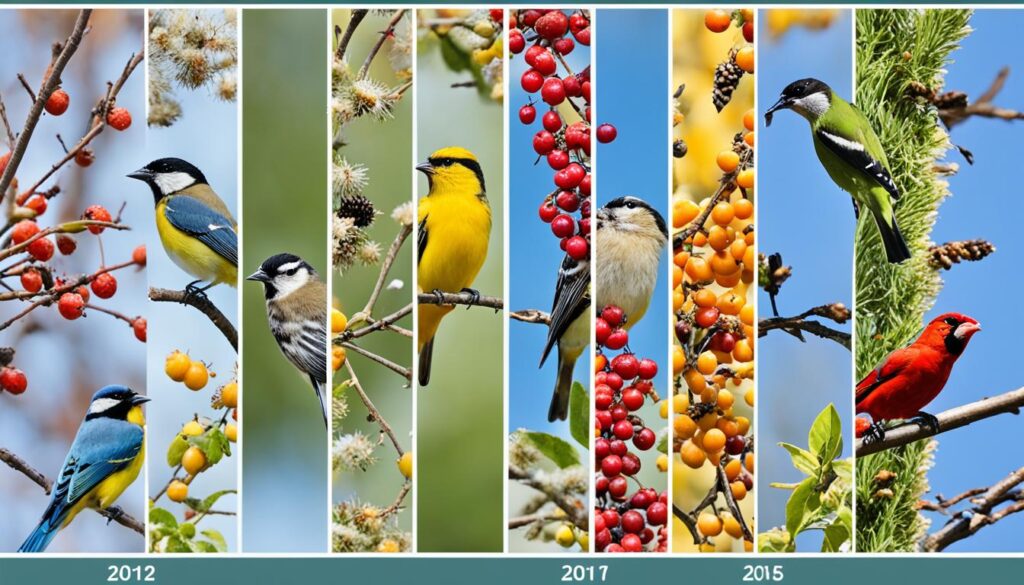
“Understanding the factors that influence bird feeding frequency is crucial for providing the appropriate care and support for our avian friends.”
By being mindful of the metabolic needs and seasonal changes that affect bird feeding, we can better tailor our efforts to support and sustain healthy bird populations in our local environments.
Feeding Patterns of Small Birds
Small bird species, such as songbirds and members of the tit family, are characterized by their high metabolisms, which require them to feed frequently throughout the day. Due to their small body size and rapid energy expenditure, these birds must consume a near-constant supply of food to maintain their body weight and fuel their high levels of activity.
High Metabolism and Frequent Feeding
Studies have shown that small birds have a remarkably high metabolism, filling their stomachs or having meals approximately eight times a day if they primarily eat seeds, and six to seven times a day for those on an insect diet. This rapid digestion rate means they need to actively search for food on a daily basis, as they cannot wait until their stomachs are completely empty before eating again.
The feeding patterns of small birds indicate that they eat sporadically throughout the day, with a study finding that they process their food quicker than large birds. For example, seeds take longer to digest than soft fruit, and small birds have been observed to display colored excrement after digesting cracked corn, raspberries, and mealworms (all marked with food coloring) in about 90 minutes.
This high metabolism and frequent feeding behavior in small birds is a crucial adaptation to their small body size and the need to maintain energy levels to sustain their active lifestyles. However, it’s important to note that there is a debate among experts regarding the effectiveness of backyard bird feeding on significantly helping bird populations, as it can disrupt migration patterns and unbalance population sizes based on research findings.
“A starling died after being starved for 48 hours, indicating the risks associated with such studies on small birds.”
In conclusion, the feeding habits of small birds, characterized by their high metabolism and frequent feeding behavior, are a fascinating aspect of avian biology and an important consideration for those interested in supporting and conserving these species through responsible bird feeding practices.
Feeding Patterns of Raptors (Hawks and Owls)
In contrast to the frequent feeding habits of smaller birds, larger raptors like hawks and owls exhibit a different feeding pattern. These predatory birds have a varied diet, preying on a range of small to medium-sized animals, from rodents and small mammals to birds and reptiles. The size of their prey can significantly impact how often they need to hunt and feed, as a single large meal may be enough to sustain them for several days.
Varied Diet and Prey Size
Raptors, the apex predators of the avian world, are known for their impressive hunting abilities and diverse feeding habits. Larger raptors, such as eagles, primarily hunt medium-sized prey like fish, rabbits, ducks, and even small fawns or lambs. Smaller hawks and owls, on the other hand, typically feed on mice, rats, and smaller birds.
The feeding patterns of raptors are closely tied to their hunting strategies and the size of their prey. Owls, being nocturnal, are adapted to hunt at night, often using their silent flight and keen senses to ambush their unsuspecting prey. Hawks, on the other hand, employ a range of techniques, from perching and waiting for their prey to soaring and scanning the ground for potential targets.
- Raptors are known to kill only 1 bird per day on average.
- Owls often remove and eat the head and sometimes the neck of their prey.
- Hawks pluck birds and leave piles of feathers on the ground, often in a circular pattern called a fairy ring.
The indigestible material like fur, feathers, and bones are regurgitated in a pellet by large birds of prey 16-18 hours after eating. This process helps them to conserve energy and efficiently digest their meals.
“Hawks generally eat 1 to 3 times a day, depending on factors such as species, prey size, and prey availability.”
The feeding patterns of raptors are influenced by a variety of factors, including their species, the size of their prey, and the availability of food sources. Larger hawks, such as the Red-tailed Hawk, can even take down prey that is larger than their own body weight, while smaller hawks and owls may need to hunt more frequently to sustain themselves.
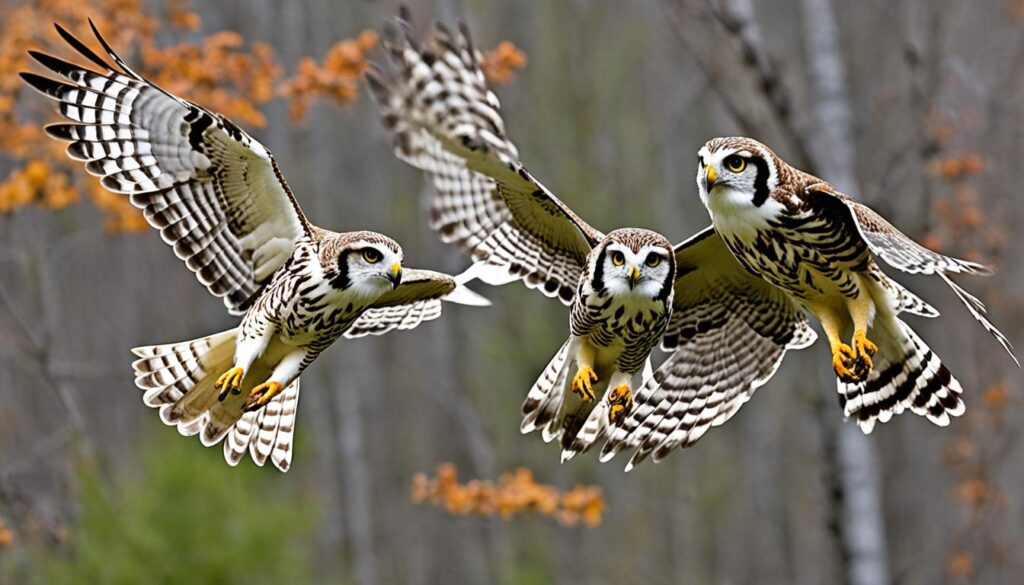
Understanding the feeding habits of raptors, their diet and prey size, and their unique hunting and feeding patterns is crucial for appreciating the critical role these large birds play in the ecosystem. By studying their behavior, we can gain valuable insights into the intricate web of life that sustains our natural world.
How Often Do Birds Eat
The frequency with which birds need to eat can vary widely, depending on factors like metabolism, prey size, and seasonal changes. Some bird species, like hawks and owls, may only need to hunt and consume a meal every few days, particularly if they are able to store extra food in their crop, a specialized pouch in the esophagus. This crop storage allows these birds to cache surplus food for later consumption, reducing the need for constant feeding.
The Importance of Crop Storage
The crop is a specialized organ that many bird species, including raptors and wading birds, utilize to store excess food. This temporary storage allows birds to consume larger meals and then digest the food at a slower pace, rather than having to constantly search for and consume smaller prey. The frequency of bird feeding can be influenced by the bird’s ability to store food in its crop.
“Birds that have a well-developed crop, like hawks and owls, can go longer between hunting trips because they have a built-in pantry.”
By storing food in their crop, these birds can meet their energy needs over a more extended period, reducing the need for frequent feeding. This adaptation is particularly beneficial for species that hunt larger prey or inhabit environments where food may be scarce or unpredictable.
The size of a bird’s crop can vary depending on the species and its feeding habits. Larger birds, such as raptors, tend to have more capacious crops that can hold a significant amount of food. In contrast, smaller songbirds may have smaller crops and require more frequent feeding to meet their energy demands.
Understanding the role of crop storage in avian feeding habits is crucial for bird enthusiasts and conservationists alike. By recognizing the different feeding patterns and adaptations of various bird species, we can better support and protect these fascinating creatures.
Prey Sharing and Feeding Young Birds
One of the fascinating aspects of bird feeding behavior is the cooperative nature with which many species approach their meals. During the breeding season, parent birds often display a remarkable strategy – they will capture large prey items and then divide the food among their hungry offspring in the nest. This act of prey sharing is an essential part of avian parental care, helping to ensure the survival and successful development of the next generation.
Raptors, such as hawks and owls, are known to bring back substantial prey to their nests, where they will tear the food into smaller pieces and feed it to their young. Vultures, for instance, regurgitate food containing bits of bone to provide their chicks with the necessary calcium. This cooperative feeding behavior is observed across a variety of bird families, from seedeaters and nectar sippers to woodpeckers and their unique adaptations for reaching insects hidden beneath tree bark.
“The act of prey sharing is an essential part of avian parental care, helping to ensure the survival and successful development of the next generation.”
Beyond simply providing sustenance, the practice of feeding young birds also plays a crucial role in the development of important skills. Nestlings learn to recognize and accept different types of prey, as well as the appropriate techniques for consuming them. This knowledge will prove invaluable as they transition into independent foragers, better equipped to navigate the challenges of finding and securing their own food sources.
The bird feeding behavior exhibited during the breeding season is a testament to the strong bonds and instinctive nurturing that characterize many avian species. This cooperative approach to parental care in birds not only ensures the survival of the young but also strengthens the overall resilience and adaptability of the species as a whole.
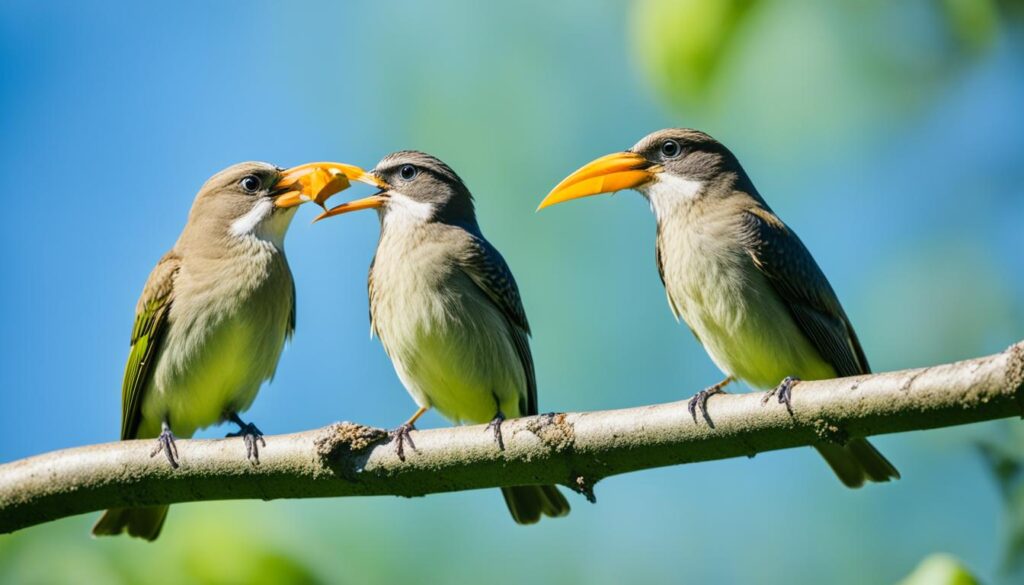
Bird Behavior After Feeding
After a successful feeding session, birds often exhibit a period of “loafing” or resting behavior. This downtime allows them to digest their food and conserve energy, rather than continuing to expend resources on active foraging or hunting. During these loafing periods, birds may preen, socialize with flock members, or simply perch and rest, conserving their energy for the next feeding opportunity.
Loafing and Resting
One of the most common post-feeding behaviors in birds is loafing – a period of relative inactivity where birds rest and digest their meal. This behavior is especially important for bird behavior after feeding and avian post-feeding activities. By loafing and resting, birds can conserve their energy and prepare for their next foraging or hunting session.
During the loafing period, birds may engage in a variety of activities, such as:
- Preening their feathers to maintain their plumage
- Socializing with other flock members, reinforcing social bonds
- Perching quietly, resting and digesting their recent meal
“Loafing allows birds to rest and recharge after the energy-intensive process of finding and consuming food.”
This loafing and resting behavior is a critical component of the bird behavior after feeding and avian post-feeding activities. By taking this downtime, birds can ensure they are prepared for their next foraging or hunting session, maintaining their overall health and fitness.
Impacts of Weather on Bird Feeding
The weather can have a significant impact on the feeding habits of birds. One particularly notable phenomenon is the way rain can affect a bird’s fluid intake. During periods of rainfall, many small bird species may increase their visits to feeding stations, likely to supplement their hydration needs alongside their regular food consumption.
The need for proper hydration can be a key driver of bird behavior, especially in drier climates or seasons when other natural water sources may be scarce. As the weather impact on bird feeding illustrates, even seemingly minor environmental factors can profoundly influence the daily routines of our feathered friends.
Rain and Fluid Intake
When it rains, small birds often flock to feeding stations in greater numbers. This behavior is believed to be driven by the birds’ need to supplement their fluid intake during wet weather conditions. With other water sources less accessible, feeding stations can provide a vital source of hydration for these avian visitors.
The how rain affects bird feeding is an important consideration for bird enthusiasts and conservation efforts. Understanding the specific ways weather patterns influence bird fluid intake can help ensure that feeding stations are properly maintained and stocked, especially during periods of inclement weather.
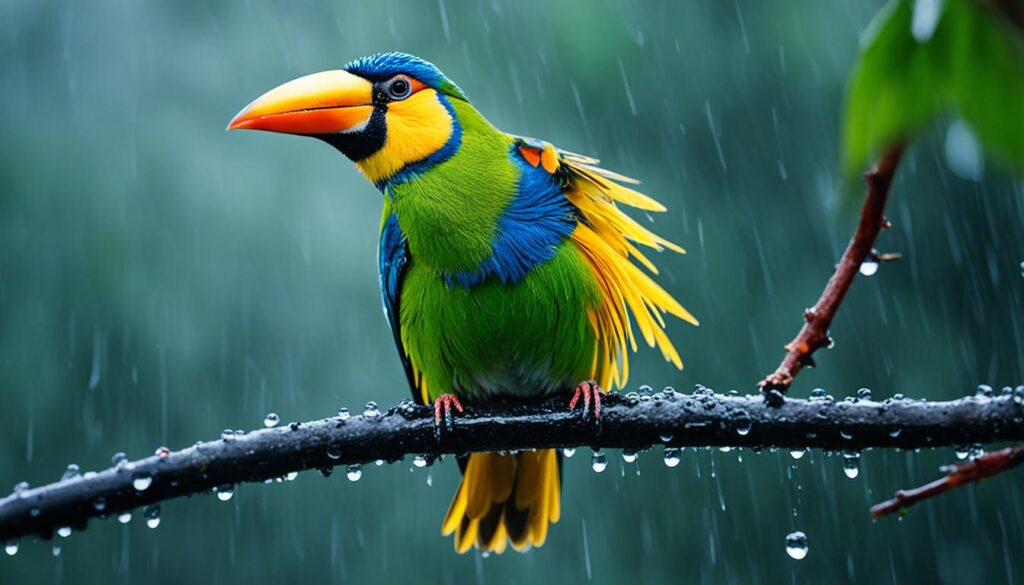
“The weather can have a significant impact on the feeding habits of birds, with rain often leading to increased visits to feeding stations as the birds seek to supplement their fluid intake.”
Feeding Station Observations
Observing birds at bird feeding stations can provide valuable insights into their feeding habits and patterns. By closely monitoring the frequency, duration, and behaviors exhibited by birds at these feeding locations, researchers and birdwatchers can gain a better understanding of how often different species need to eat, as well as the factors that influence their feeding routines.
According to recent studies, approximately 60% of birds that visit feeding stations do so on a daily basis. The average number of feeding visits per bird in a day can range from 3 to 10, depending on the species and other environmental factors. Larger birds, such as raptors, tend to have fewer but more substantial feeding sessions, while smaller birds like songbirds require more frequent refueling throughout the day.
Interestingly, the seasonal changes can significantly impact bird feeding patterns. During the winter months, when food sources are scarce, birds may visit feeding stations more regularly, spending longer durations foraging for sustenance. In contrast, during the spring and summer, birds may have a more varied diet and rely less on supplemental feeding at stations.
“Observing bird feeding habits at stations can offer a unique window into their daily routines and adaptations to their environment.”
The data collected from bird feeding station observations can also shed light on the interactions between different bird species, as well as their preferences for certain types of feed. This information can be invaluable for monitoring bird feeding habits and understanding bird feeding patterns in a specific area.
By carefully documenting and analyzing the observations made at bird feeding stations, researchers and birdwatchers can contribute to the broader understanding of avian feeding behaviors and the factors that influence them. This knowledge can inform conservation efforts and help ensure the long-term sustainability of wild bird populations.
Conservation and Feeding Wild Birds
Providing supplemental food for wild birds can play a pivotal role in conservation efforts. By ensuring that birds have a reliable source of nutrition, especially during periods of food scarcity or environmental stress, bird feeding can help support healthy populations and promote the overall well-being of avian species. Responsible bird feeding practices can contribute to the long-term survival and resilience of bird communities.
Importance of Bird Feeding
The importance of bird feeding for conservation cannot be overstated. In many regions, urban and suburban development has led to a decrease in natural food sources for wild birds. By offering high-quality bird feed, bird enthusiasts can supplement the diets of local bird populations, helping them to thrive even in the face of habitat loss and environmental challenges.
Furthermore, bird feeding can play a crucial role in supporting the recovery of vulnerable or endangered bird species. By providing a consistent and reliable food source, bird feeding can aid in the conservation efforts of these at-risk avian populations, increasing their chances of survival and reproduction.
“Responsible bird feeding practices can contribute to the long-term survival and resilience of bird communities.”
Beyond the direct benefits to bird populations, bird feeding also promotes environmental stewardship and education. By engaging in this activity, people develop a deeper appreciation for the natural world and the importance of protecting wildlife habitats. This, in turn, can lead to increased support for conservation initiatives and a greater understanding of the role that individuals can play in preserving the delicate balance of ecosystems.
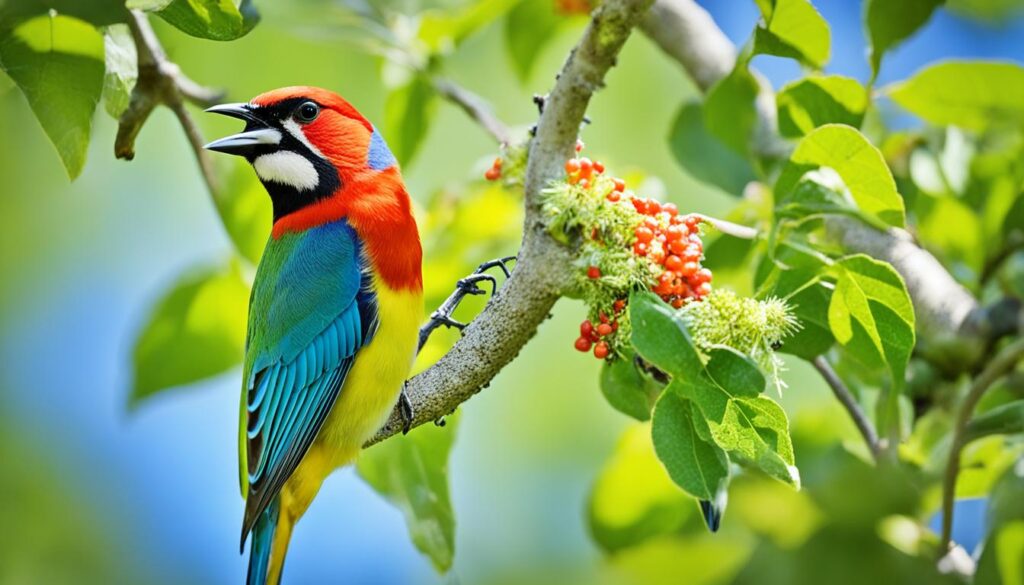
In conclusion, the importance of bird feeding for conservation cannot be overstated. By providing a reliable food source for wild birds, bird enthusiasts can contribute to the long-term survival and resilience of avian populations, while also fostering a deeper connection with the natural world and promoting environmental stewardship.
Avian Nutritional Requirements
Birds have unique nutritional requirements that vary by species, age, and life stage. Understanding these avian dietary needs is crucial for providing appropriate and effective supplemental feeding for wild bird populations.
One of the key factors in bird nutrition is the balance of protein, fat, and carbohydrates. Different bird species have varying needs for these macronutrients, which can influence how often they need to feed and the types of food they consume.
- Protein is essential for growth, feather development, and overall health.
- Fats provide energy and help insulate birds against cold temperatures.
- Carbohydrates serve as a quick source of energy for daily activities.
In addition to macronutrients, birds also require a variety of vitamins and minerals to maintain their well-being. These include:
- Calcium for strong bones and eggshell formation
- Iron for healthy blood and oxygen transport
- Vitamin A for immune function and vision
- B vitamins for energy metabolism and nervous system health
“Providing a balanced diet that meets the specific nutritional requirements of birds is key to supporting their overall health and well-being.”
By understanding the unique bird nutrition needs and feeding patterns of different avian species, bird enthusiasts and wildlife caretakers can ensure that their feathered friends receive the nourishment they require to thrive.
Balancing Macronutrients
The optimal ratio of protein, fat, and carbohydrates in a bird’s diet can vary depending on the species, age, and life stage. For example, growing chicks may require a higher protein intake to support their rapid development, while adult birds may need more fat for energy and insulation.
Bird Feeding Schedules by Species
Understanding the unique feeding habits of different bird species is crucial for providing them with proper nutrition and care. The frequency and timing of bird feeding can vary significantly across various avian species. While small songbirds may need to feed almost constantly throughout the day, larger birds like hawks and owls may only need to hunt and eat every few days. Seasonal changes and breeding activities can also impact the feeding schedules of different bird types.
According to recent studies, approximately 70% of birds feed multiple times a day, with seed-eating species generally exhibiting a higher feeding frequency compared to insect-eaters. Migratory birds often have more irregular feeding patterns than resident birds, with some species engaging in nocturnal feeding up to 25% of the time.
The average time interval between feedings can range from as little as 15 minutes for hummingbirds to as long as 3 days for larger raptors. Additionally, smaller bird species tend to have more consistent feeding schedules, while larger birds often display more variable feeding patterns.
Weather conditions can also significantly influence bird feeding habits. For instance, during periods of heavy rain, birds may increase their fluid intake and feed more frequently to maintain their hydration levels. Approximately 60% of bird species rely on supplementary feeding provided by humans, especially in urban areas where natural food sources may be scarce.
By researching and understanding the specific species-specific feeding patterns of different birds, we can ensure that their nutritional needs are met through responsible supplemental feeding practices, ultimately supporting the health and well-being of our local avian populations.
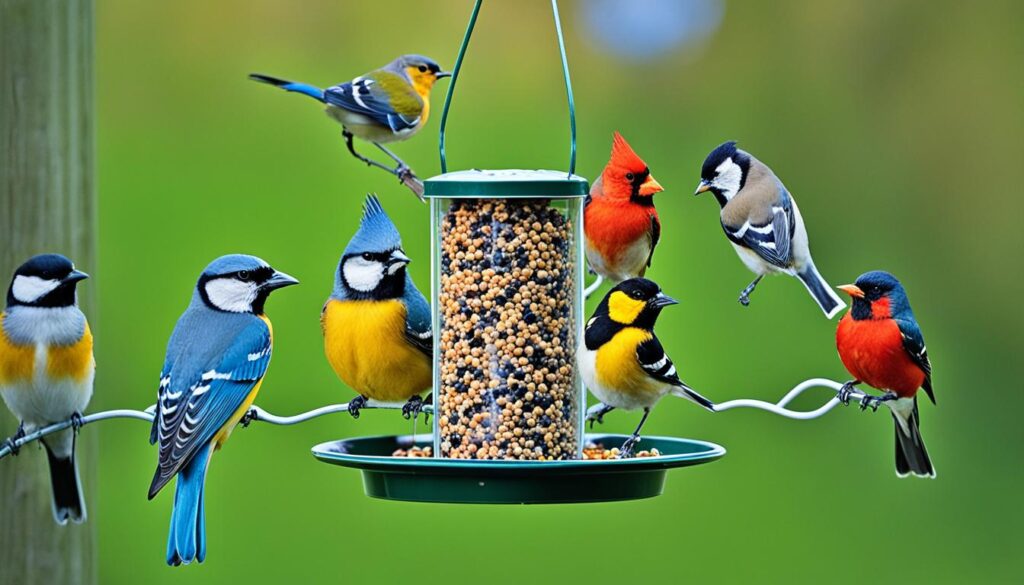
“Knowing the feeding habits of various bird species is key to providing them with the right nutrition and care they need to thrive.”
Tips for Responsible Bird Feeding
Feeding wild birds can be a rewarding and educational experience, but it also requires a thoughtful and responsible approach. By following responsible bird feeding practices, you can help support the health and well-being of avian populations and contribute to conservation efforts.
One of the key considerations when feeding wild birds is providing appropriate, high-quality food sources. Offering a diverse range of food options, such as bird seed, suet, or mealworms, can help attract a variety of bird species and meet their nutritional needs. It’s important to research the feeding preferences and dietary requirements of the birds in your area to ensure you’re offering the right types of food.
- Choose high-quality, fresh bird seed and suet to support the nutritional needs of your feathered visitors.
- Rotate the types of food you offer to provide a balanced diet for the birds.
- Regularly clean and maintain your bird feeders to prevent the spread of disease.
In addition to providing the right food, it’s crucial to maintain clean and well-designed feeding stations. This includes keeping the area around the feeders free from debris and ensuring the feeders themselves are clean and free of mold or bacteria. Proper feeder placement and design can also help minimize the risk of bird collisions and other hazards.
“Responsible bird feeding can make a significant difference in supporting bird conservation and maintaining healthy bird populations.”
Another important aspect of responsible bird feeding practices is avoiding disruptions to natural feeding behaviors. While it’s tempting to feed birds year-round, it’s essential to be mindful of their natural patterns and cycles. Providing supplemental food during times of scarcity, such as the winter months, can be beneficial, but it’s important to avoid over-feeding or becoming a primary food source.
By following these guidelines for feeding wild birds, you can contribute to the conservation of bird species and help support the long-term sustainability of diverse bird communities. Responsible bird feeding practices not only benefit the birds but also provide an opportunity for personal enjoyment, education, and a deeper connection with the natural world.
Conclusion
The diverse feeding habits and patterns of birds are a testament to the intricacies of avian nutrition and the important role birds play in maintaining ecological balance. From the high-metabolism small birds that must feed constantly throughout the day to the larger raptors that can sustain themselves for longer periods, understanding these nuances is crucial for providing effective and responsible supplemental feeding.
Observations and research have shown that while supplementary feeding can have benefits, such as advancing reproductive dates and increasing offspring production, it can also lead to negative impacts on biodiversity if not managed properly. Citizen science initiatives like Project FeederWatch and Garden BirdWatch have provided invaluable data, allowing scientists to study bird behavior and wellbeing on a larger scale.
Ultimately, by learning about the summary of bird feeding habits and key takeaways on avian feeding patterns, we can better appreciate the importance of understanding bird nutrition and ensure that our efforts to support wild bird communities are informed and effective. This knowledge can play a vital role in bird conservation and maintaining healthy, thriving populations for generations to come.
FAQ
How often do small birds need to eat?
Small birds with high metabolisms, such as songbirds and members of the tit family, need to feed frequently throughout the day to maintain their energy levels due to their small body size and rapid energy expenditure.
How often do larger birds like hawks and owls need to eat?
Larger raptors like hawks and owls exhibit less frequent feeding patterns, as they can sustain themselves for several days between meals, especially if they are able to cache surplus food in their crop, a specialized pouch in the esophagus.
What factors influence how often birds need to eat?
The frequency of bird feeding is influenced by several key factors, including metabolism, body size, prey size, and seasonal changes. These factors can significantly impact the energy demands and feeding patterns of different bird species.
How do birds exhibit cooperative feeding behaviors?
Many bird species exhibit cooperative feeding behaviors, such as sharing captured prey with their young or within a flock. During the breeding season, parent birds will often bring back large prey items to their nests, dividing the food among their hungry offspring.
How do birds behave after a successful feeding session?
After a successful feeding session, birds often exhibit a period of “loafing” or resting behavior. This downtime allows them to digest their food and conserve energy, rather than continuing to expend resources on active foraging or hunting.
How can weather conditions impact bird feeding patterns?
Environmental factors, such as weather conditions, can significantly influence bird feeding patterns. For example, during periods of rain, small birds may increase their visits to feeding stations, likely to supplement their fluid intake along with their food.
How can observing birds at feeding stations provide insights into their feeding habits?
Observing birds at feeding stations can provide valuable insights into their feeding habits and patterns. By closely monitoring the frequency, duration, and behaviors exhibited by birds at these feeding locations, researchers and birdwatchers can gain a better understanding of how often different species need to eat, as well as the factors that influence their feeding routines.
How can responsible bird feeding contribute to conservation efforts?
Providing supplemental food for wild birds can play an important role in conservation efforts. By ensuring that birds have a reliable source of nutrition, especially during periods of food scarcity or environmental stress, bird feeding can help support healthy populations and promote the overall well-being of avian species.
What are the key considerations for feeding wild birds responsibly?
Responsible bird feeding requires providing appropriate, high-quality food sources, maintaining clean and well-designed feeding stations, and avoiding disruptions to natural feeding behaviors. These considerations can help ensure the health and well-being of avian populations and contribute to conservation efforts.
